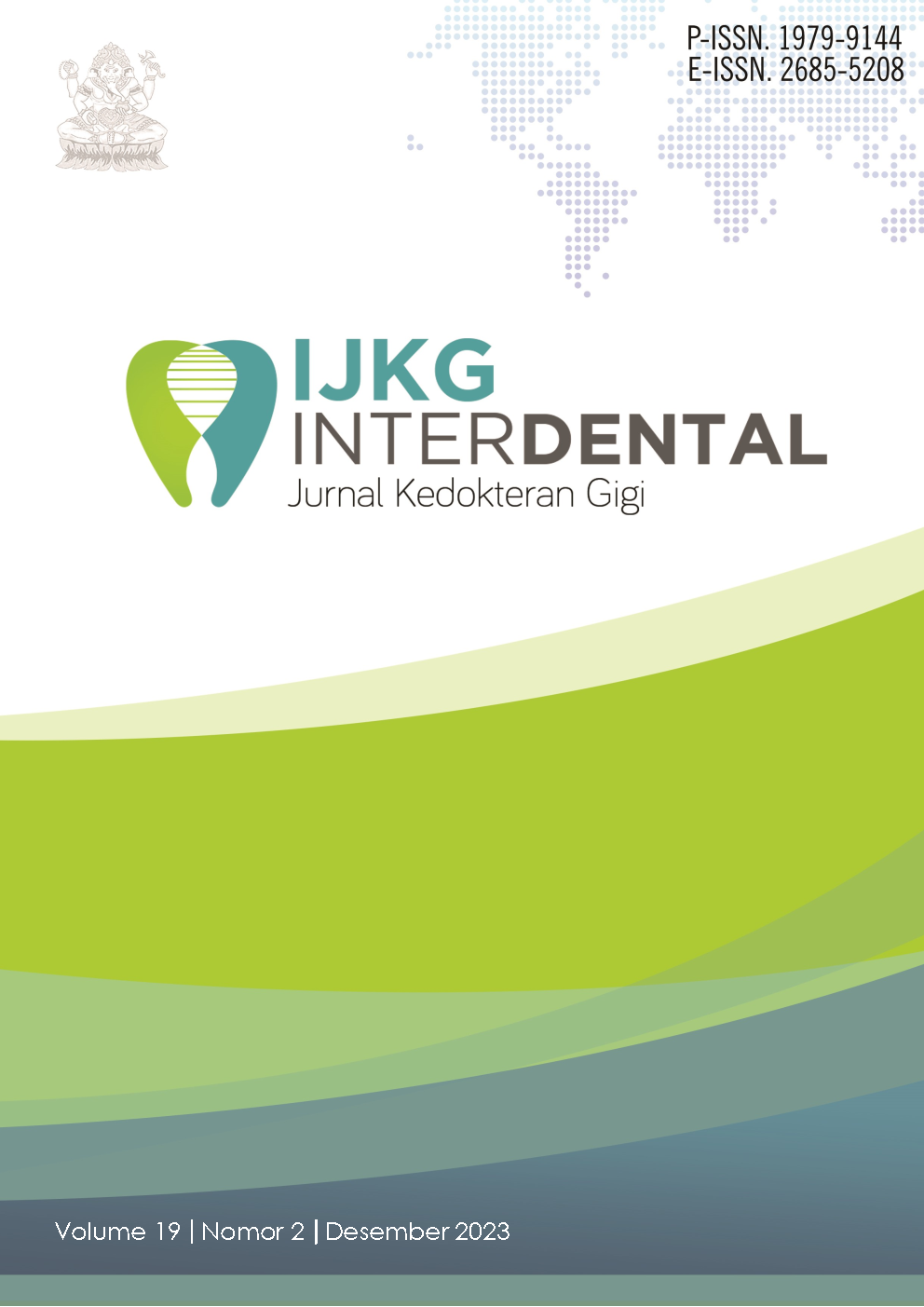IDENTIFICATION AND TREATMENT OF ERYTHEMA MULTIFORME INDUCED BY ALLOPURINOL
DOI:
https://doi.org/10.46862/interdental.v19i2.7664Keywords:
Allopurinol , erythema multiforme , identification, therapyAbstract
Introduction: Allopurinol is a xanthine oxidase inhibitor and has become established as the drug of choice for preventing and treating chronic gout. Erythema multiforme (EM) is an immune-mediated reaction that involves the skin and sometimes the mucosa. Many cases of EM are caused by drugs, one of which is allopurinol. The purpose of the case study is to explain the identification of allopurinol as a predisposing factor for EM and how it is treated.
Case. A 56-year-old woman came with complaints of scabs on her lips for 1 week ago, and had been treated with corticosteroid ointment for 3 days. Extraoral examination showed hemorrhagic crusts on the upper and lower lips with erosive surrounded by erythematous margins. On the extremity found a target lesion on the right hand. Based on the examination, the patient was diagnosed with Erythema Multiforme with a differential diagnosis of herpes labialis and herpes associated erythema multiforme.
Case Management. The therapy in this case was giving antihistamines for 1 week, NaCl 0.9% compresses on the lips for 30 minutes 3 times a day, after 2 weeks of treatment added with the application of 1% hydrocortisone cream as an anti-inflammatory and petroleum jelly on the lips as a moisturizer.
Conclusion. Identification of the etiology of this EM case was carried out through anamnesis and history of drugs consumed as well as administration of topical corticosteroids as anti-inflammatories and oral antihistamines to reduce allergic reactions.
Downloads
References
Ramasamy SN, Korb-Wells CS, Kannangara DRW, et al. Allopurinol hypersensitivity: A systematic review of all published cases, 1950-2012. Drug Saf. 2013;36(10):953-980. doi:10.1007/s40264-013-0084-0
Yun J, Mattsson J, Schnyder K, et al. Allopurinol hypersensitivity is primarily mediated by dose-dependent oxypurinol-specific T cell response. Clin Exp Allergy. 2013;43(11):1246-1255. doi:10.1111/cea.12184
Stamp LK, Day RO, Yun J. Allopurinol hypersensitivity: Investigating the cause and minimizing the risk. Nat Rev Rheumatol. 2016;12(4):235-242. doi:10.1038/nrrheum.2015.132
Sousa-Pinto B, Correia C, Gomes L, et al. HLA and delayed drug-induced hypersensitivity. Int Arch Allergy Immunol. 2016;170(3):163-179. doi:10.1159/000448217
Samim F, Auluck A, Zed C, Williams PM. Erythema multiforme. A review of epidemiology, pathogenesis, clinical features, and treatment. Dent Clin North Am. 2013;57(4):583-596. doi:10.1016/j.cden.2013.07.001
Torrelo A, Andina D, Santonja C, et al. Erythema multiforme-like lesions in children and COVID-19. Pediatr Dermatol. 2020;37(3):442-446. doi:10.1111/pde.14246
de Risi-Pugliese T, Sbidian E, Ingen-Housz-Oro S, Le Cleach L. Interventions for erythema multiforme: a systematic review. J Eur Acad Dermatology Venereol. 2019;33(5):842-849. doi:10.1111/jdv.15447
Soares A, Sokumbi O. Recent updates in the treatment of erythema multiforme. Med. 2021;57(9). doi:10.3390/medicina57090921
Celentano A, Tovaru S, Yap T, Adamo D, Aria M, Mignogna MD. Oral erythema multiforme: Trends and clinical findings of a large retrospective European case series. Oral Surg Oral Med Oral Pathol Oral Radiol. 2015;120(6):707-716. doi:10.1016/j.oooo.2015.08.010
Khan P, Mudassar M, Baloch FA, Waqas M, Khan A. Spectrum of morphological changes in erythema multiforme. J Med Sci. 2020;28(3):218-222.
Calogiuri G, Nettis E, Di Leo E, Foti C, Ferrannini A, Butani L. Allopurinol hypersensitivity reactions: Desensitization strategies and new therapeutic alternative molecules. Inflamm Allergy - Drug Targets. 2013;12(1):19-28. doi:10.2174/1871528111312010004
Sousan Kolahi MT. CASE REPORT Oral allopurinol desensitization. J Case Reports Pract. 2014;2(1):32-33.
Yun J, Cai F, Lee FJ, Pichler WJ. T-cell-mediated drug hypersensitivity: Immune mechanisms and their clinical relevance. Asia Pac Allergy. 2016;6(2):77-89. doi:10.5415/apallergy.2016.6.2.77
Shah SN, Chauhan GR, Manjunatha BS, Dagrus K. Drug induced erythema multiforme: Two case series with review of literature. J Clin Diagnostic Res. 2014;8(9):ZH01-ZH04. doi:10.7860/JCDR/2014/10173.4761
Srivastava B, Bhardwaj R, Khanchandani R, Ansari ZM, Belwal G. Rifampicin- and allopurinol-induced Stevens-Johnson syndrome : A case series. 2021;65(1):51-54. doi:10.25259/IJPP
Chen CB, Abe R, Pan RY, et al. An updated review of the molecular mechanisms in drug hypersensitivity. J Immunol Res. 2018;2018. doi:10.1155/2018/6431694
Trayes KP, Love G, Studdiford JS. Erythema multiforme: Recognition and management. Am Fam Physician. 2019;100(2):82-88.
Varga MA. Moist Wound Healing : Past and Present. Wound Care Canada. 2012;10(2):12-19. https://www.woundscanada.ca/docman/public/wound-care-canada-magazine/2012-vol-10-no-2/465-wcc-spring-2012-v10n2-moist-wound/file
H. E, Supriadi D, Sunarya W. Perbedaan Kompres Nacl 0 , 9 % dengan Kompres Alkohol 70 % Terhadap Penurunan Intensitas Nyeri Pada Pasien Flebitis. J Kedokt dan Kesehat. 2015;2(3):245-251.
Fitzsimons R, Van Der Poel LA, Thornhill W, Du Toit G, Shah N, Brough HA. Antihistamine use in children. Arch Dis Child Educ Pract Ed. 2015;100(3):122-131. doi:10.1136/archdischild-2013-304446
da Rosa MI, Souza SL, de Farias BF, Pires PDS, Dondossola ER, dos Reis MEF. Efficacy of topical 5% acyclovir–1% hydrocortisone cream (ME-609) for treatment of herpes labialis: A systematic review. An Acad Bras Cienc. 2015;87(2):1415-1420. doi:10.1590/0001-3765201520140701
Downloads
Published
How to Cite
Issue
Section
License
Copyright (c) 2023 I Nyoman Gede Juwita Putra, Raziv Ganesha, I Gusti Ngurah Putra Dermawan

This work is licensed under a Creative Commons Attribution-ShareAlike 4.0 International License.
- Every manuscript submitted to must observe the policy and terms set by the Interdental Jurnal Kedokteran Gigi (IJKG)
- Publication rights to manuscript content published by the Interdental Jurnal Kedokteran Gigi (IJKG) is owned by the journal with the consent and approval of the author(s) concerned.
- Full texts of electronically published manuscripts can be accessed free of charge and used according to the license shown below.













